|
|
Kurokawa Kisho. Metabolism in Architecture. — London, 1977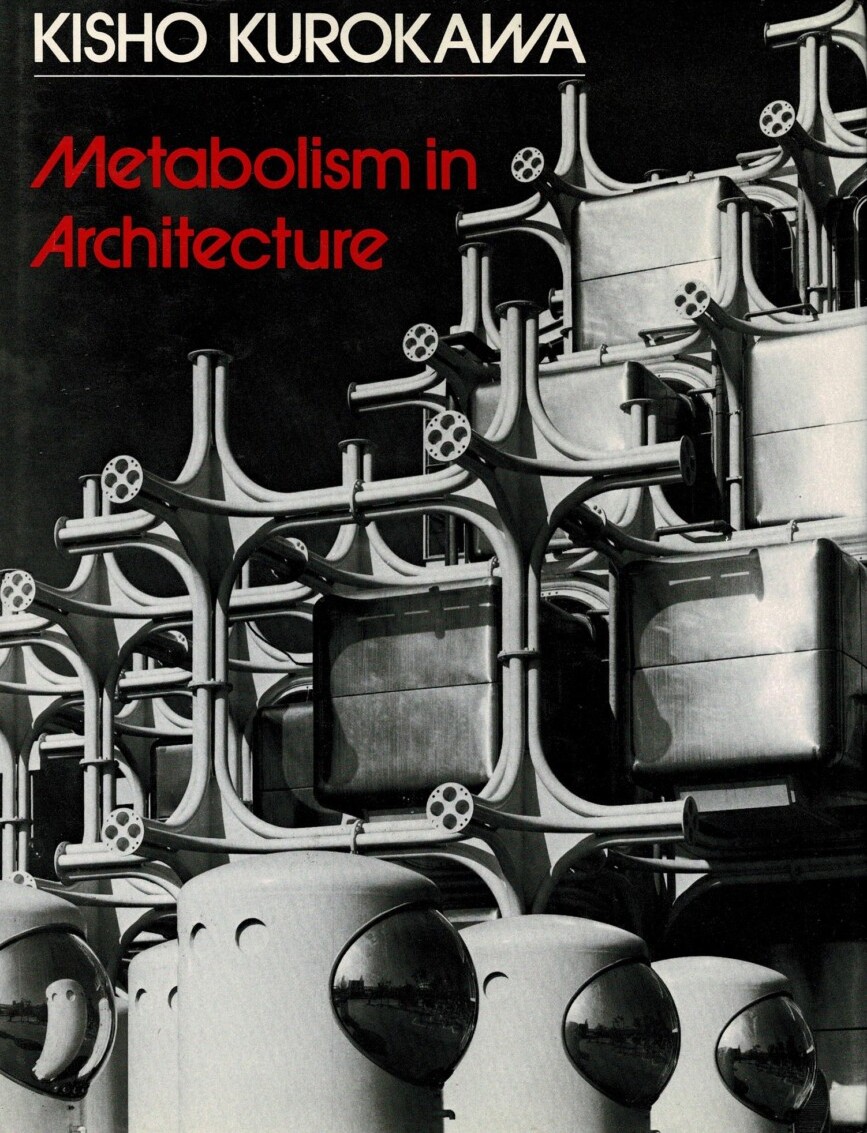 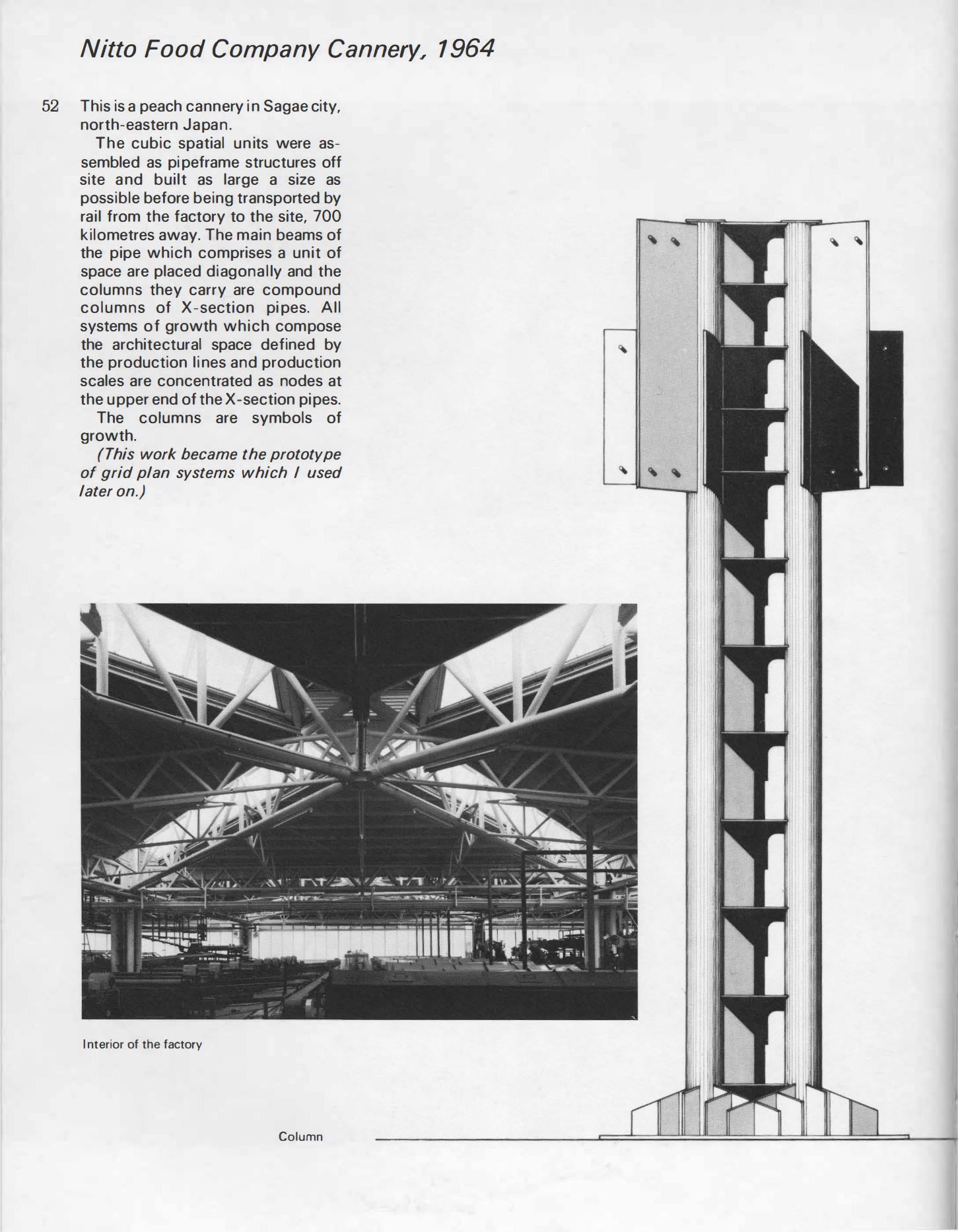 Metabolism in Architecture / Kurokawa Kisho. — London : Studio Vista, 1977. — 208 p. : ill. — ISBN 0289707331Contents
Preface 7
Introduction by Charles Jencks 8
Chapter 1
1 The Philosophy of Metabolism 23
2 The Origin and History of the Metabolist Movement 41
Agricultural City, 1960 46
Museum for Kumamoto City, 1975 48
Service Area for the Tokyo-Nagoya Highway, 1969 50
Nitto Food Company Cannery, 1964 52
Floating City, Kasumigaura, 1961 54
Helix Structure, 1961 56
Hishino New Town, 1966 57
Linear City, ‘Metamorphosis’, 1965 58
Fujisawa New Town, 1968 60
Redevelopment Plan for Downtown Kawasaki, 1970 61
Regional Plan for the Vasto-San Salvo Area, 1975 62
Beaubourg Centre, Paris, 1971 64
Metapolis – the Hishino Plan 67
Chapter 2
1 Capsule Declaration 75
2 Meta-Architecture 86
Prefabricated Apartment House, 1962 92
Discotheque Space Capsule, 1968 95
Floating Factory, ‘Metabonate’, 1969 96
Capsule House in the Theme Pavilion, Expo ’70, 1970 98
Takara Beautillion, Expo ’70,1970 101
Nakagin Capsule Tower, 1972 105
Capsule House ‘K’, 1972 112
Concrete Capsule House, 1975 116
Capsule Village, 1972 118
Sony Tower, Osaka, 1975 120
Koito Building, 1974 122
Um Al-Kanhazeer Project, 1975 124
Drive-In Restaurant, ‘Otome Toge’, 1969 126
Toshiba Ihi Pavilion, Expo ’70, 1970 128
Big Box, 1974 132
Chapter 3
Architecture of the Street 135
Nishijin Labour Centre, 1962 143
Central Lodge in the National Children’s Land, 1965, 146
Hans Christian Andersen Memorial Museum, 1965 149
Kyoto International Conference Hall, 1963 151
National Theatre, 1963 153
The TANU Headquarters Building, Tanzania, 1972 154
The Conference City, Abu Dhabi, 1975 159
Hotel in Sofia, Bulgaria, 1975 161
Azabu Town Houses, 1974 163
Ishikawa Cultural Centre, 1975 165
Exhibition Space, Vasto, Italy, 1975 167
Daido Insurance Building, Tokyo, 1975 168
Chapter 4
1 Media Space, or En-Space 171
2 Notes on Media Space (En-Space) 180
Head Office of the Fukuoka Bank, 1975 188
Sagae City Hall, 1967 194
National Ethnology Museum, 1975 196
The Resort Town Okutadeshina, 1965 198
Yamagata Resort Centre, 1967 199
Waki-cho City Hall, 1975 201
Sports Centre, Vasto, Italy, 1975 203
Bibliography 205
Credits for Photographs 208
Preface
This book is a collection of my most important works – in architecture and theoretical writing – from the period 1960 to 1975. I have chosen the title Metabolism in Architecture despite the fact that the Metabolist group, formed in 1960, now carries on virtually no activity as a group, and despite the many changes in my work and thought in the fifteen years since the Metabolist movement began. The word ‘metabolism’ nevertheless stands in order to secure a wider understanding of the concept and because there is value in using it in this extended sense. I was also led to select this title out of a desire to reflect upon and organize the relation between my writings and works of these fifteen years and Metabolist thought.
For the convenience of the reader the book is organized into four chapters. The architecture and writings are not in chronological order, although the date at which each work was designed or written is important to me. As we live in an international society with rapid communication in which we are constantly open to new influences the date for each piece indicates the spirit in which it was written.
Although I reject traditionalism, I attach great importance to the influence which the culture of one country may exert on another. It is my belief that the cultures of different countries will stand individually but together, allied with technology, to provide the future language of architecture. That modern architecture appears diffuse is proof that the cultures of different regions each contribute to the language of modern architecture, and as a result modern architecture will probably come to speak not with a lingua franca but with a complex and many-faceted language.
Kisho Kurokawa
Introduction
by Charles Jencks
At first glance Kisho Kurokawa seems more like a statistic dreamed up by the Japanese Board of Trade than a living person. Press reports invariably start with a roll-call of triumphs achieved at the age of forty: thirty-five major buildings designed and built, seventeen books written, four new towns of his design under construction, head of an architect’s firm with one hundred employees and an urban design office of forty. And then there are the odder numbers: Kurokawa heads a think tank of thirty (called ominously the Institute for Social Engineering), he appears monthly before a TV audience of thirty million, he works eighteen hours in twenty-four (which means ‘he sleeps an hour longer than Napoleon’) and, unlikely category, he is Japan’s third most popular person (this was before Tanaka’s resignation; perhaps he has moved up to number two). A preposterous success story, sounding slightly bogus to Western ears (architects can’t be that popular) – but then many things about Kurokawa raise eyebrows and challenge stereotypes. For instance, his Herculean workday would make him the typical Japanese ‘fanatic’, yet he goes about it in a normal, relaxed way as if he were on a holiday. Or his immaculate dress – Gucci shoes and Cartier wristwatch – mark him as Westernized yet he is perfectly at home (literally) performing tea ceremonies in his own house. Contradiction and paradox are an everyday occurrence.
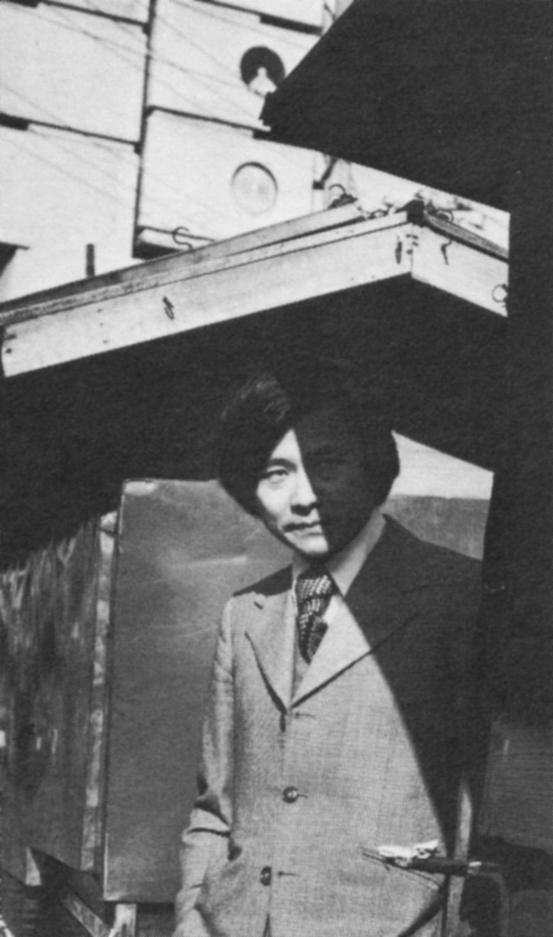 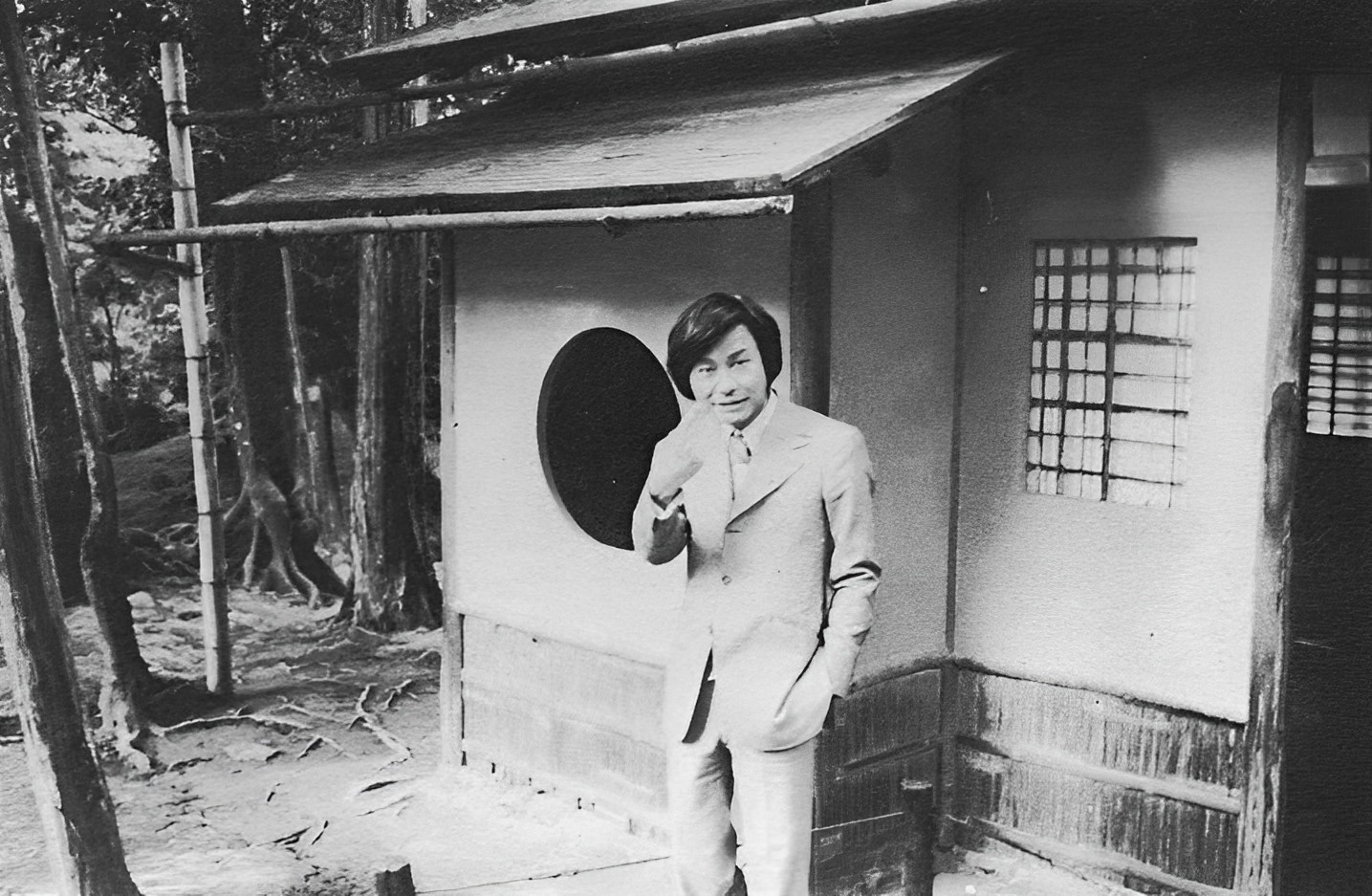
Metabolism
Kurokawa first came into the public eye in 1960 when, along with other architects, he founded Metabolism, an architectural movement and philosophy of change. This philosophy was invented, almost as propaganda, for the World Design Conference held that year in Tokyo. Kurokawa was twenty-six, the other architects in their early thirties. They had studied the politics of European avant-garde movements and were determined to fashion an ‘ism’ which would compete with those in the West.
Strangely, they were aided in this essentially elitist activity by Japanese industry which was, at the same time, aggressively trying to invade Western markets. It was hoped the World Design Conference would unify the various professions responsible for Japanese trade and give them a single style and coordination identifiable to the outside world. (This economic motive, incidentally, also led to the formation of the German Werkbund in 1907, with comparable results: a new style fusing art and industry, which would increase ‘good taste’ at an ever-increasing profit.) The Japanese Chamber of Commerce sponsored the affair. Kurokawa and others met every two weeks at night and discussed such designs as Kikutake’s utopian project ‘City over the Sea’ – a series of gigantic cylinders located on what they called ‘artificial land’ (80 per cent of Japan is mountainous and habitable space has always been at a premium).
Such utopian schemes gave birth to the notion of the city as an organism which changes at various rates. Kikutake wanted to become a doctor before he became an architect so the word ‘Metabolism’ was coined for their manifesto and philosophy. Kurokawa, however, gives another account: he says they first evolved their designs of plug-in buildings and megastructures and then consulted a dictionary for inspiration.
At any rate, Metabolism became an extended biological analogy meant to replace the mechanical analogy of orthodox modern architecture. It compared buildings and cities to an energy process found in all of life: the cycles of change, the constant renewal and destruction of organic tissue. This metaphor was, however, not so new as it looked to the West. In many ways it was just the ancient Taoist philosophy of cosmic change and eternal growth which makes for endless variations on the same theme.
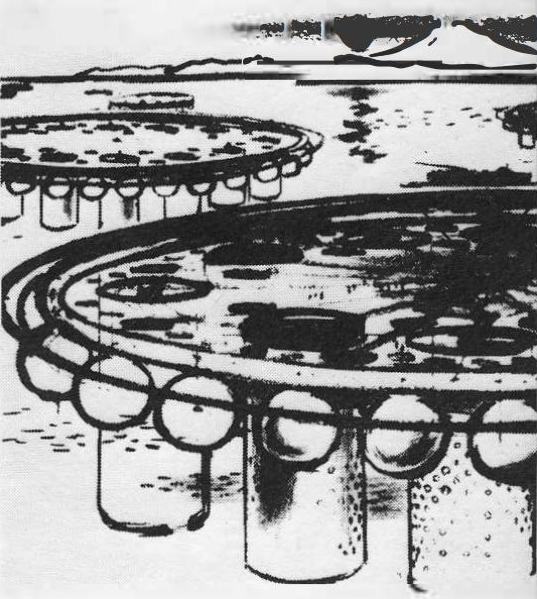
Furthermore the practice of incessant change was common to Japanese architecture with its wood buildings and Shinto shrines, which are recreated every twenty years. These shrines, of the emperor cult, are not revivals or copies in the Western sense, but nearly exact replicas whose identical form and re-creation stop time, or at least do away with historical change. In like manner, the Metabolists’ philosophy of change paradoxically stops the clock. By clearly separating parts of a building or city which have different rates of change, they allow certain structures to remain undisturbed when others wear out. Their ideal is to design a city so flexible in its connections that its parts could grow, transform themselves and die while the whole animal went on living.
Metabolic theory distinguishes between different rates of obsolescence (the wearing out of mechanical equipment is faster than that of structure etc.) so that one doesn’t have to destroy a whole building, or part of a city, every time one part breaks down. Kurokawa even extends this ideal of putting together highly disparate and dissectible parts to the relation between Eastern and Western culture.
‘A hundred years ago, when we first began importing European civilization, people wore kimonos; to these they later added shoes. This was not a harmonious combination but it was a very good way even so. The Japanese way is to mix everything, not as a synthesis but as a situation. Situation is reality to us because our whole tradition is a tradition of flexibility and change. There is no real opposition to progress here because we do not decide what is right and what is wrong, or what is good and what is bad – that is a very European kind of thinking. What we do is to separate them but accept both.’
This may sound like muddled thinking, or hypocrisy, or immorality to a Westerner and probably heresy to a Christian. But as Kurokawa said regarding Buddhism and change, ‘I can be Buddha, but you can’t be Christ.’ What he had in mind was the infinite transformation prophesied in his philosophy, the belief that one is reincarnated in every age, perhaps as a plant the first time, or an ‘enlightened one’ (a Buddha), the next.
‘Individuality belongs to certain systems, but they must also be equal. I, me, you, tree, Buddha are equal because they have identity, jiga, and the same “cycle”. We don’t kill an animal in Buddhism. You will be me after I die – or a tree. A tree is father, or Buddha. This is the opposite of Christianity where things are each different – that is not interchangeable.’
One can see here the direct connection of Metabolist cycles of change with Buddhist reincarnation, prompting the pun that Metabolism should really be called ‘Metabuddhism’. Kurokawa contrasts it in so many ways with the static notions of the West.
‘We have in Japan an aesthetic of death, whereas you have an aesthetic of eternity. The Ise shrines are rebuilt every twenty years in the same form, or spirit; whereas you try to preserve the actual Greek Temple, the original material, as if it could last for eternity.’
This attempt to see man-made things as an extension of nature is the traditional idea of Japanese architecture with its organic site planning and natural use of materials left in an unfinished state. The building complex Kurokawa most admires is the Katsura Detached Palace in Kyoto, built in the seventeenth century and extended (metabolically) since then in a series of pavilions placed on the diagonal. When he took me around it, he spoke of the building and landscape in his own private language. Like so many modern architects he had a curious jargon, a set of keywords and concepts invented anew for himself.
Each pavilion at Katsura is a jiga, a Buddhist word for self and identity. Connect jigas together in an overlapping manner on their corners and you have what he calls en (or what traditional historians call echelon planning). Engawa then means the ‘in-between space’, the verandah space between inside and outside, or the space between two pavilions, or the street space between two buildings. In fact for Kurokawa it can mean an empty space seen positively or, the concept most dear to the Metabolists, semi-public space. As we will see on page 171, there are many meanings for engawa which Kurokawa ejects from his ‘word-making machine’. Basically, he values it so highly because it seems to overcome the dualism of the West, the either/or logic which is alien to Buddhism.
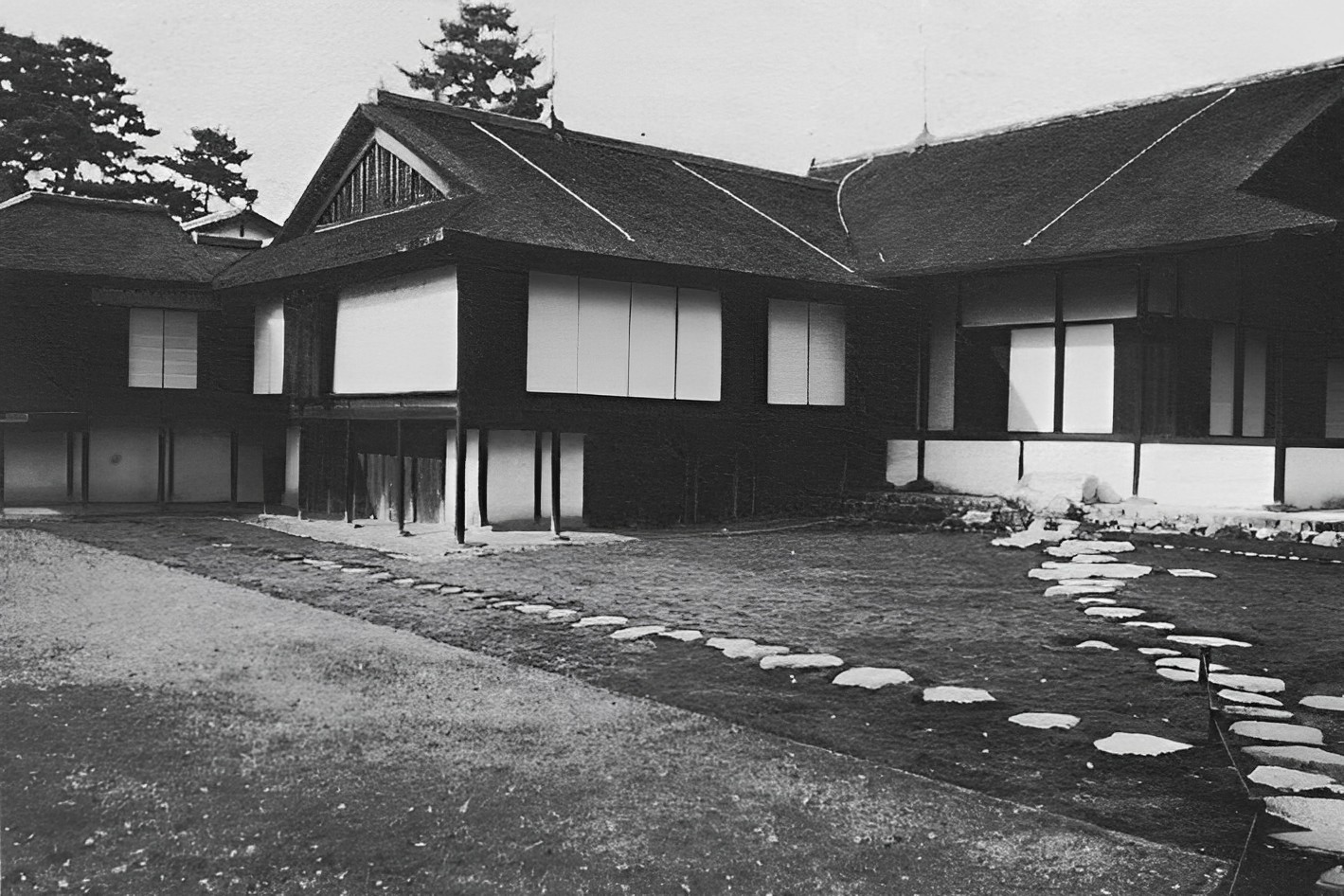
All this is really quite maddening and possibly pretentious since there is nothing very new in the idea except the neologisms, and one has to learn thirty or forty to understand what Kurokawa explicitly intends. There are ‘infra-structuring and master-spacing’, ‘fibrous form and porous space’, ‘urban connectors and clusters’, ‘point stimulation and interiorization’, enough for anyone to balk at. Furthermore, every other word in this list is roughly synonymous so we have, if I may add to the jargon, semantic inflation. And it is still worse because each Metabolist has a different set of neologisms.
And yet there are advantages. Each neologism allows Kurokawa to take over an habitual idea for himself, a necessity for an artist who is going to manipulate it in a new way. By naming ideas with new tags, not only does he shift the meaning and invent a metalanguage to discuss the new ideas, but also possesses or owns the ideas (at least psychologically). Kurokawa admits that his concepts are not the scientific categories they appear to be but rather convenient fictions which allow him to control design. They certainly allow him to give an overriding theme or unity to each work. The neologism functions as the concetto, or ‘concept’, did for the seventeenth-century Italian artist; as the unifying idea which directs the whole project. This gives Japanese architecture, as well as his work, a formal conviction usually absent in modern architecture, which is so often a compromise of endless requirements.
Kurokawa talks about engawa and his other concepts with a religious attachment – so strong that it takes the place of conventional morality, or at least the Western morality of a right opposed to a wrong position. He, in common with certain Buddhists, assumes a contradictory position, which includes evil within it. This inevitably leads to compromise or the design of questionable buildings for dubious clients. Thus I asked who he would not build for and what sort of building he wouldn’t construct (a prison?).
‘I will build for anyone if my concepts are realized – they come first. I have a natural way with clients; I am not pure like Le Corbusier. I accept things from society even if they conflict with my ideas – but that’s ok. In another case I can make my ideas very clear. For instance, in the Hokkaido Prince Hotel I was asked to design the interior in French Renaissance style.’ (A smile came over his face.) ‘Well, I made a bad copy. I modified the Renaissance to reduce the cost. It’s my original Renaissance, from the Renaissance. People enjoy it very much, but some architects don’t like it. They create a perfect art which is pure, but not architecture which must relate to society.’
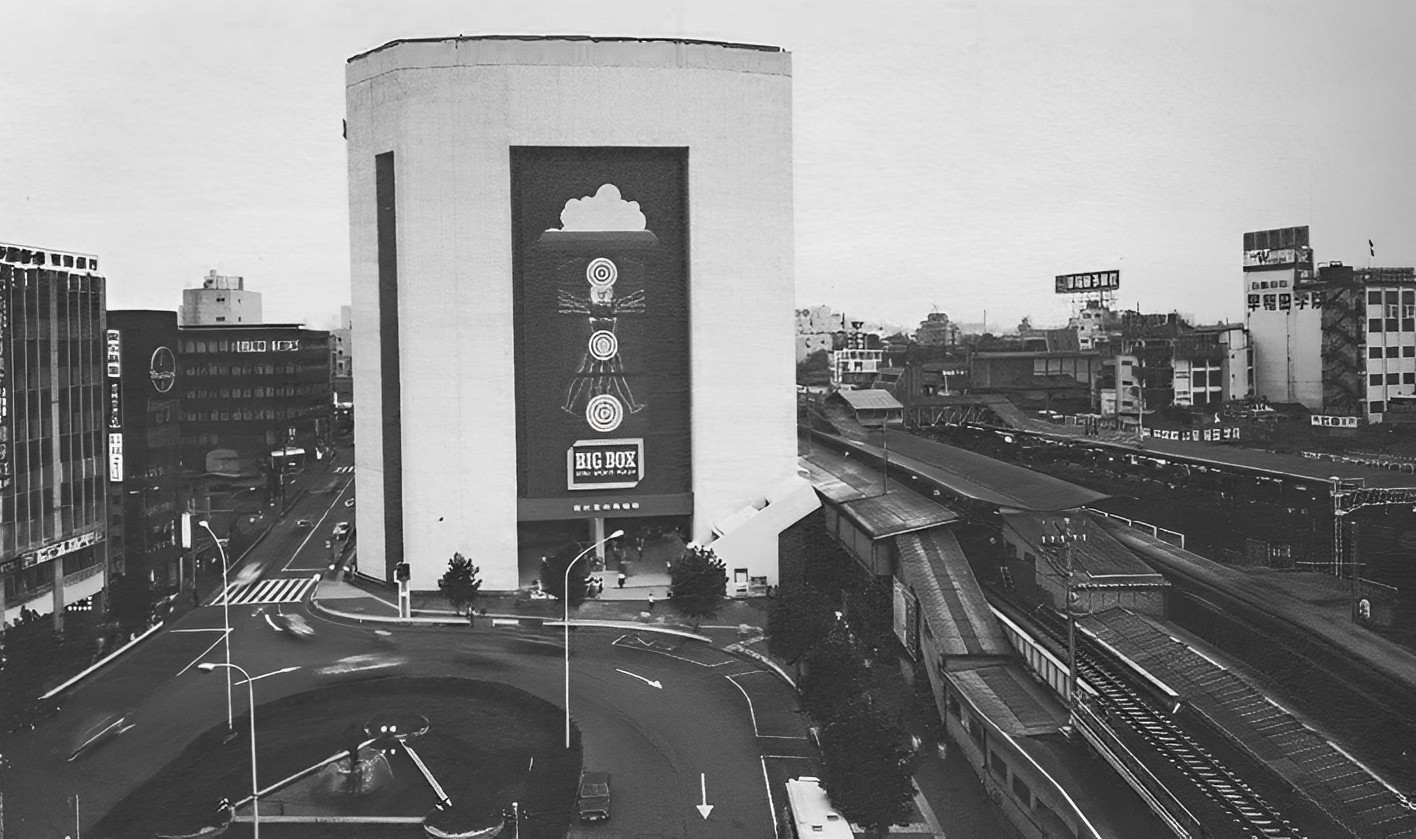 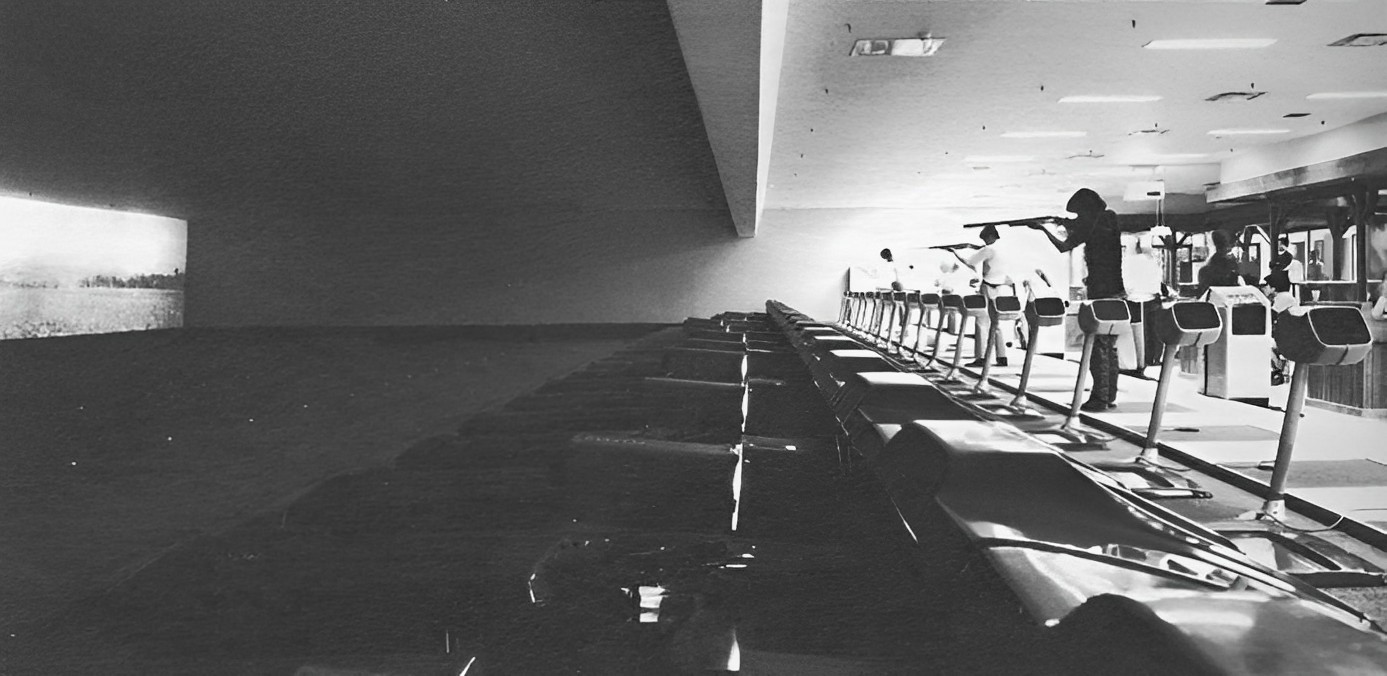
As so often, direct questions led to a series of answers which were not strictly relevant but nonetheless very illuminating of his approach. When I pointed out how Warholian he was being – ‘modifying the Renaissance to reduce the cost’ – he answered straight, ‘I’m not so funny as Andy Warhol’ – probably the truth, but his pronouncements often seemed as amusing and laconic.
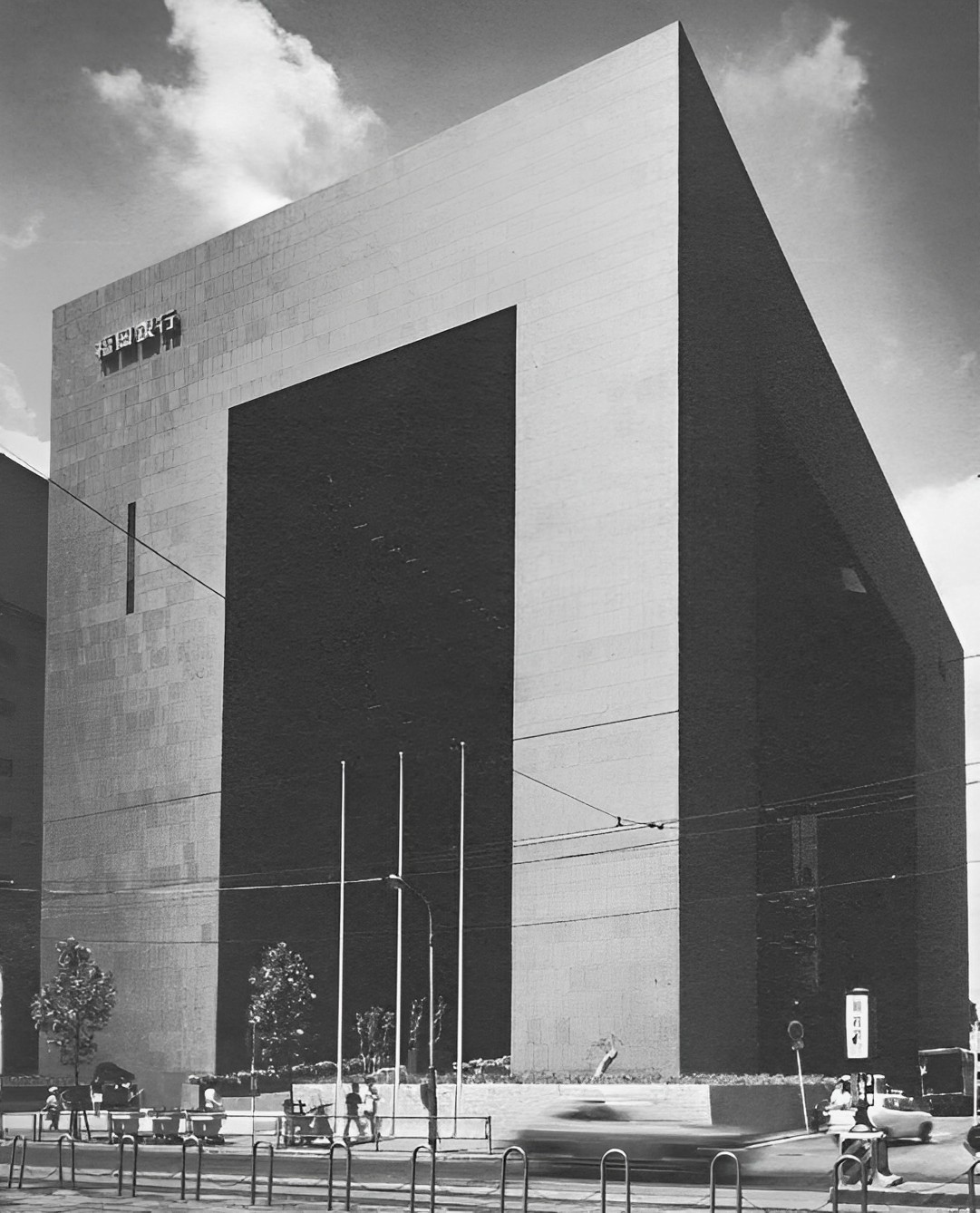 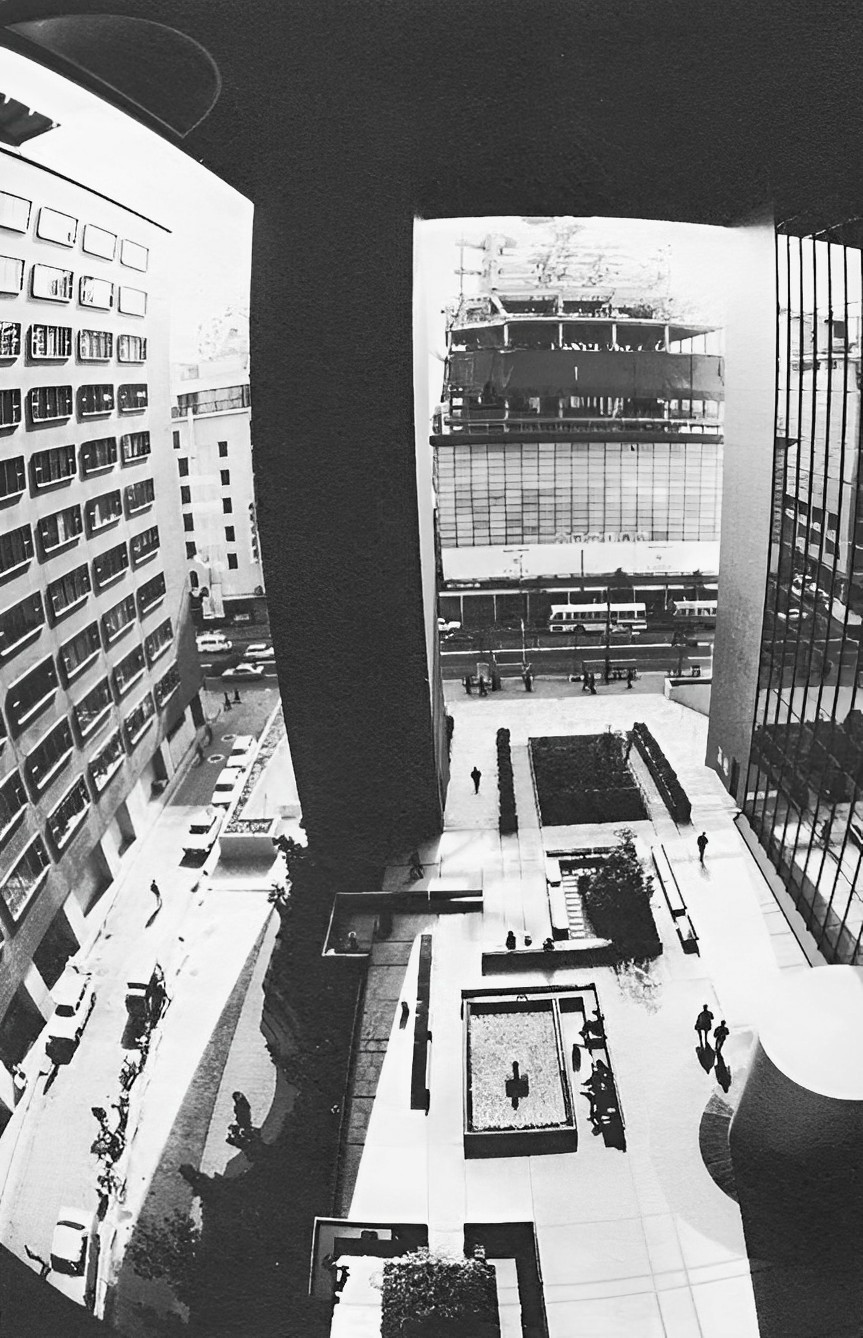
‘The concept of this building for a bank is engawa – to create some intermediate relation to the environment, where the people can travel into the building because it has this semi-public space (rather like a large covered courtyard). Thus it’s good for children, it’s a safe street without cars, it’s a public roof to avoid the rain. It was not necessary for the client, nor for the function of a bank, but I provided engawa. How can we connect private functions to society? This is not a problem of shape, style or artistic treatment. The Renaissance style is ok, it’s not so important. My philosophy is the main category, engawa, connection space and jiga, capsule space. People want space; and capsules as shapes or styles don’t matter.
‘My intention is to change the structure of the architectural industry, of mass production. People think my capsules are “inhuman” and that builders must construct houses by hand on the site. Like Ruskin, the humanism of a craft. But this is not humanism, it’s not good for labourers to work in dark spaces in terrible conditions on the building site. And putting bricks on top of each other is not a craft, it’s dehumanizing. So I design engawa semi-public spaces, and jiga mass-produced capsules to change society and labour. My concepts come first, I will design any building, except an atomic bomb factory or one used for destructive ends, as long as I can get my concepts realized.’
The Organization
Later, Kurokawa told me that he actually had a ‘Kurokawa Concept Committee’ in his firm to see if he were being consistent in his development and whether his buildings were working according to script. I was incredulous at this, since no Western architect makes such recurrent studies of the way his buildings are being used. The idea of ‘user studies and participatory design’ is still with us a pious hope, whereas Kurokawa seems to be practising it as a matter of course (although to what extent I wasn’t able to discover).
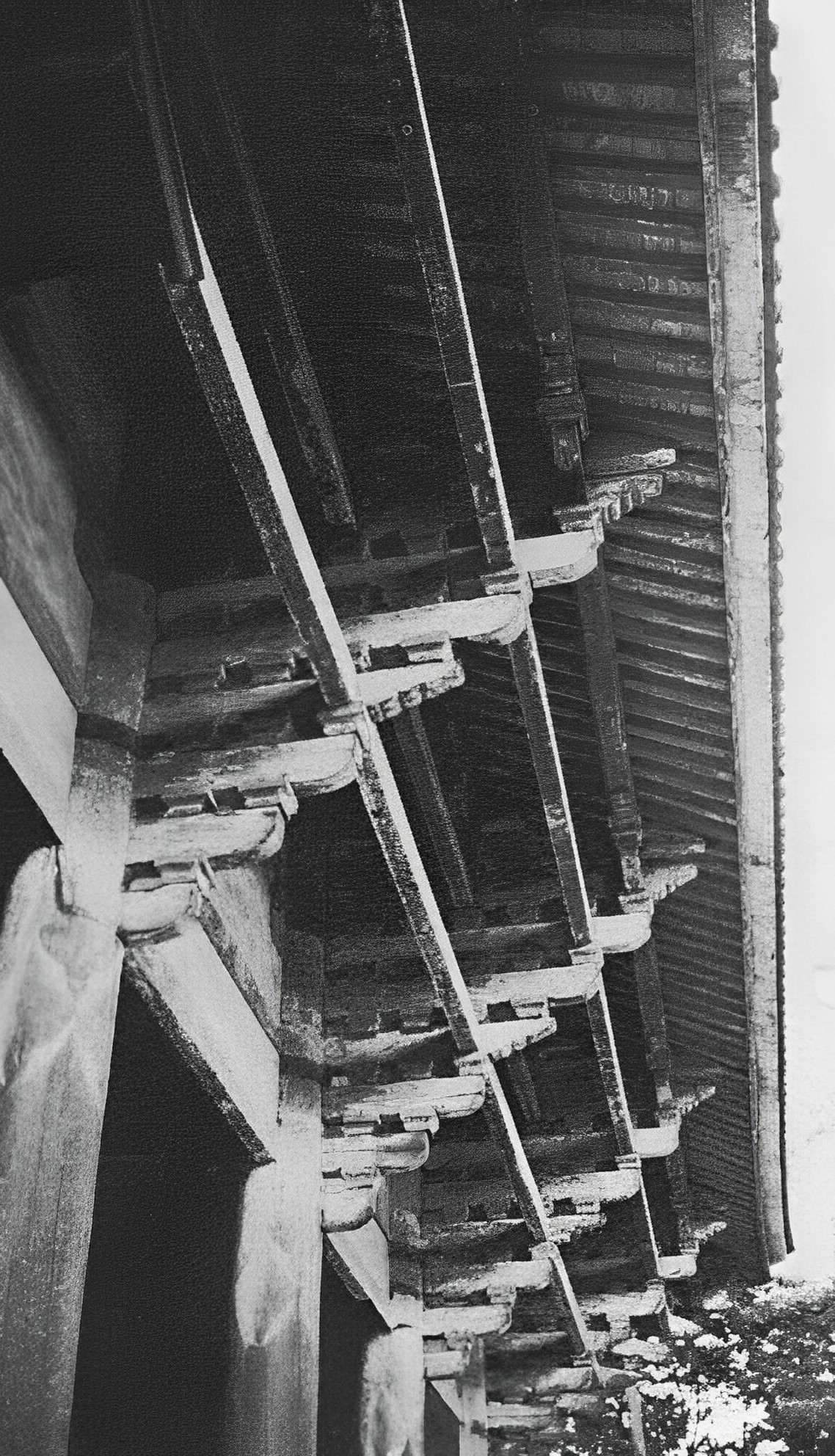
Basically there are three committees in his firm: the first one in charge of ‘checking and evaluating space’, another on ‘planning’ and a third the ‘concept committee’.
‘They ask me what’s my philosophy for each building and if I can’t answer, they attack me. This is stimulation for me – so I always must be hot. The first committee will get buildings to evaluate and then may re-design them. It must start with my own buildings and say “How do we use this?” – then produce a long manual on the correct way of using it. Sometimes, if my client hasn’t much money and there is a fault with the building, I will pay for repairs. I’ll change the light bulbs and do more extensive things because the building must be used in the right way.
This is a rare and curious responsibility for an architect to accept. Usually this obligation stops the minute the building is handed over to the client – a very arbitrary and misleading point in time since any building takes years to work correctly. How much Kurokawa’s continued responsibility is unique to him or shared with Japanese industry, and its paternalism, is a matter of conjecture. Both are certainly different from Western business with its sharp distinctions between public duty and private ownership.
Indeed Kurokawa’s firm operates differently. Many of his hundred draughtsmen and designers work through the lunch hour and into the night; they may even sleep in the office, which is equipped for this. Kurokawa’s notorious eighteen-hour working day brought the comparison with Napoleon (also like Napoleon his small stature commands a strong physical presence). And there is the usual company loyalty and personal devotion that goes with a Japanese firm created by an individual. But apart from this, there is a critical spirit which goes against the stereotype we have of such firms.
‘One week, all my staff, all 140, will go a hundred miles south of Tokyo to a hotel for a three-day seminar. I will give the first lecture for six hours, from seven in the morning to one. This year the theme is architectural history. I select the lecturers from my staff, twenty in all, who will give personal histories of recent architects like Le Corbusier and Bruno Taut. If people go to sleep during the seminar, they’re hit by a stick a man carries around for this job – but they don’t go to sleep. Before they lecture, I give a lecture about what they will lecture on – so we prepare throughout the year.’ (He notices my expression of bemused concern.) ‘Of course, hitting a man with a stick is what Zen masters used to do.
‘These seminars are necessary for me to communicate what concepts I have – it’s very hard to communicate. This year I will explain all of my history with slides; without this communication I can’t organize and my staff don’t know what I think.’ (Another smile came across my face as I imagined running a Western firm this way. Kurokawa sensed the irony and pressed his point further.) ‘These seminars have been running for three years. The first one was on Baroque space and en, my concept of engawa, the in-between space. The second was on political and social problems – in what fields I am working and why.’ (By now Western and Eastern notions of participation were opposed to the breaking point.) ‘Last night a member of my staff changed my design for the garden of a hotel. This was terrible, because he didn’t understand me – I was furious. My staff is my body – if one of them errs, I am angry with myself.’
‘Myself’ – the last word I expected in such a context! But Western stereotypes of Japanese society, of paternalism and conformity, are simply too crude to distinguish the peculiar mix of individual creativity within social conformity. Is a draughtsman in his firm as independent and critical as one in a large Western firm? The question is almost ludicrous, even if worth asking, because such opposite qualities have to be compared: loyalty versus autonomy; hard working hours versus comparatively leisurely work that is often monotonous; identification of the self with the architectural product versus the pragmatic connection of the hired draughtsman to the building he churns out. I don’t know which system is better, but imagine Richard Seifert or Skidmore, Owings and Merrill taking their draughtsmen for a weekend in Brighton to lecture them for six solid hours on aesthetic and ethical systems enunciated first by St Thomas Aquinas and caning them if they dozed off. One is forced to think again about corporate success, because clearly in Japan it need not mean loss of vigour and creativity.
Capsules
Kurokawa is often referred to as the ‘capsule architect’, a characterization he both encourages by polemic and deplores. ‘Capsule architecture’ developed from his own Metabolist researches in prefabrication done in the late fifties, which culminated in a project for a giant block which could incorporate standard elements; basically five equal elements put together like a meccano set (see The Prefabricated Apartment House, pages 92–4). The elements and image, while mass-produced, were actually based on traditional models of the farmhouse and tatami mat. It was a typical product of modern Japanese design having all the ambiguity of the figure-ground illusion: looked at one way it seemed totally futurist, from another angle totally traditional. Of course it was a combination, but one so subtle and intricate that I could not tell where the two aspects met, or even existed.
The second, genuinely Metabolist building that Kurokawa actually built was the Takara Pavilion for Expo ’70 – a series of prefabricated steel capsules suspended within a cage of bent steel tubes. Here finally was the flexibility, growth and change which had been talked about for ten years. The whole building was erected in a week and dismantled quickly after Expo. There was a clear visual and technical separation between different systems and their rates of change. Above all the unfinished image with its exposed flange ends ready to grab on some new structures and capsules finally showed the world what Metabolism would look like when fully metabolic. And yet it was still, disconcertingly, traditional. The capsules were really conventional pavilions, shoin, and the flange ends were really these elaborate brackets found under the eaves of every Buddhist temple.
‘The Takara pavilion was built in steel, which is only possible for Expo and not for housing. ’ (Actually Kurokawa has used steel for housing.) ‘The people understand that this is the image of what can be in two hundred years – they call me a futurist and say, unfortunately, that I am the capsule architect. The people totally accept my concept ... but then they don’t ask me to build their houses.’ (Almost all his work is large public building.) ‘We must keep the traditional way of life and then add on something new, a capsule. We do this all the time.’
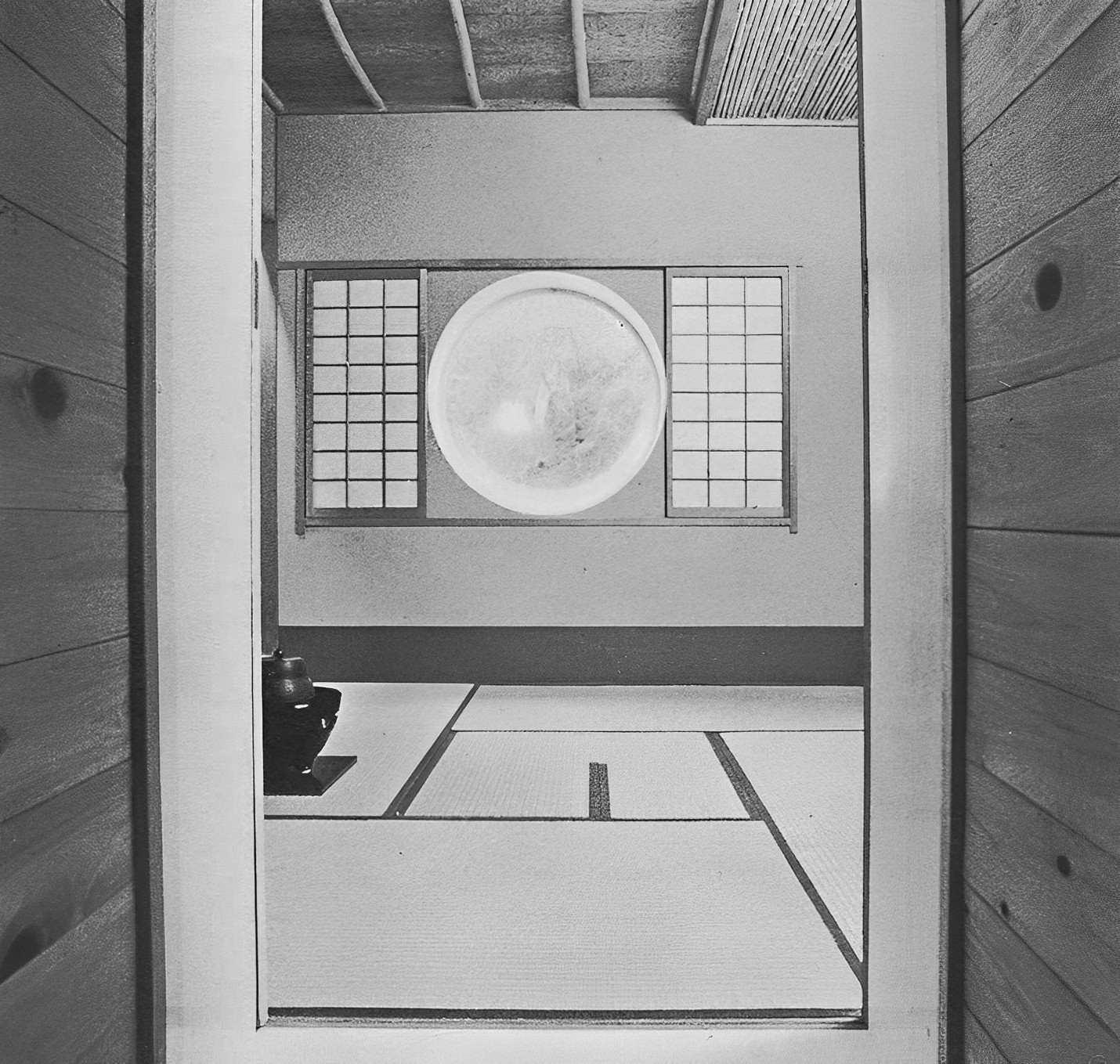
One traditional house he has built, with capsules attached, is a summer retreat for himself. Surprisingly he has seen it only twice in two years and then for a few moments; he hasn’t taken a vacation in twelve years. This house is a good example of the collision between ancient and modern since one of the steel capsules, looking like a washing machine from the outside, actually contains a traditional tea ceremony room on the inside. The circular window works equally in both contexts. For this collision, Kurokawa has coined the phrase ‘antagonistic coexistence’ – perhaps an ironic comment on the way Russia and America should have run their foreign policy. Like engawa, to which it is related, antagonistic coexistence can be found throughout his work – in the joints of the buildings and in the collision of two different structural systems.
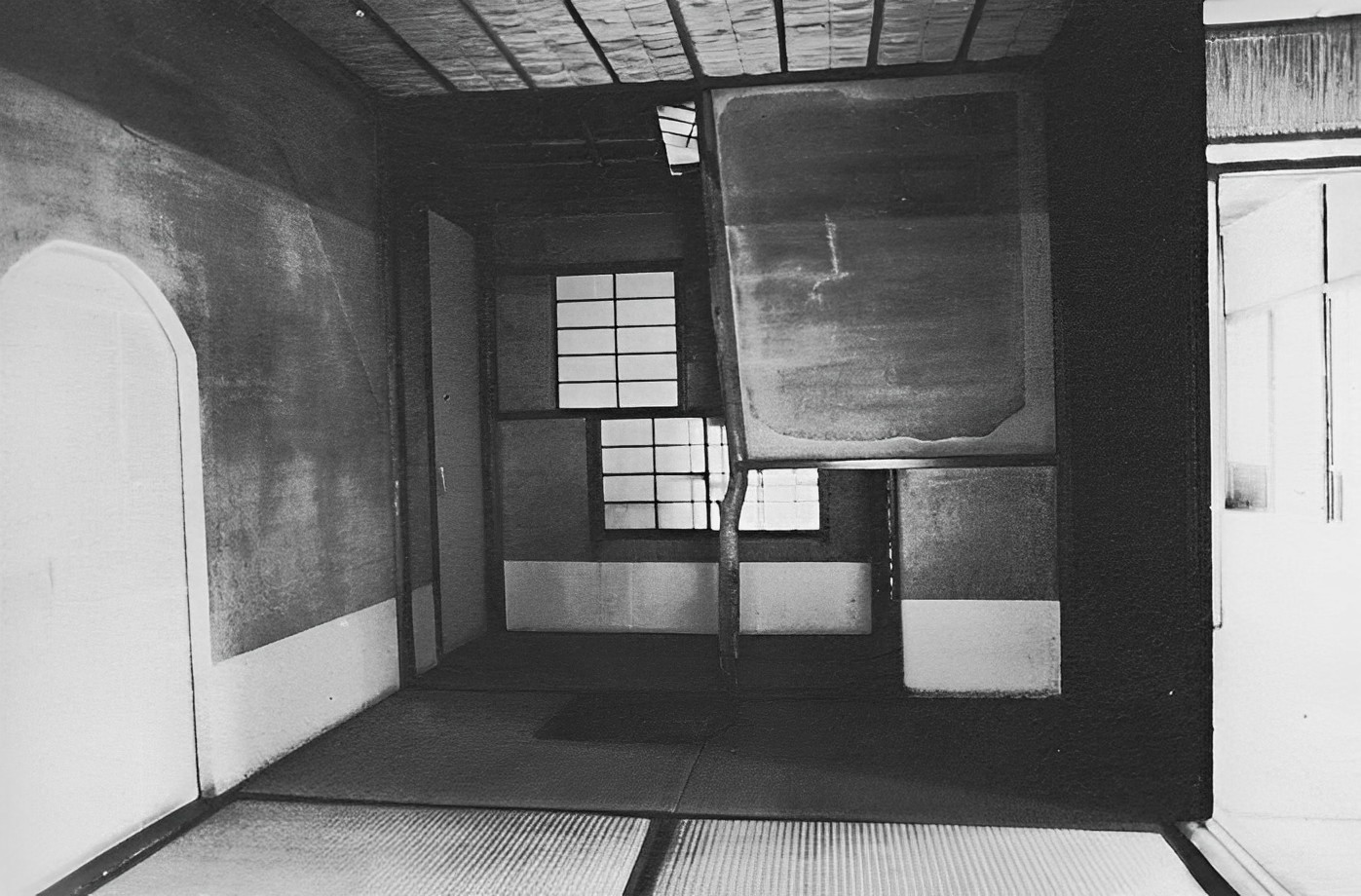
It is present in the Nakagin Tower, his most famous capsule building to date, finished in Tokyo in 1972. Here again the tatami proportions of the room (roughly 4 by 2.5 metres) exist antagonistically with the hardware of a totally self-sufficient space capsule. All the furniture is built in – the bedside control console, the stereo tape-deck and calculators – and yet the tiny space and proportions are the conventional ones. He combines steel capsules (modified from shipping containers) with all sorts of traditional components existing on the market. Behind this philosophy of confrontation is the idea of stimulation and the notion that Japanese life is best when challenged from the outside, from China in the ninth century or Europe and America today. His buildings often show this visually; while harmonious in part, they have unfinished elements, discordant notes, asymmetrical balance. A Westerner might find them beautiful, but compared to the sublime integration of traditional building they are assertive and imperfect. Yet here again Kurokawa is being traditional when we think he is most futurist. Tea pavilions always have to be asymmetrical and unfinished, to let the imagination complete the work.
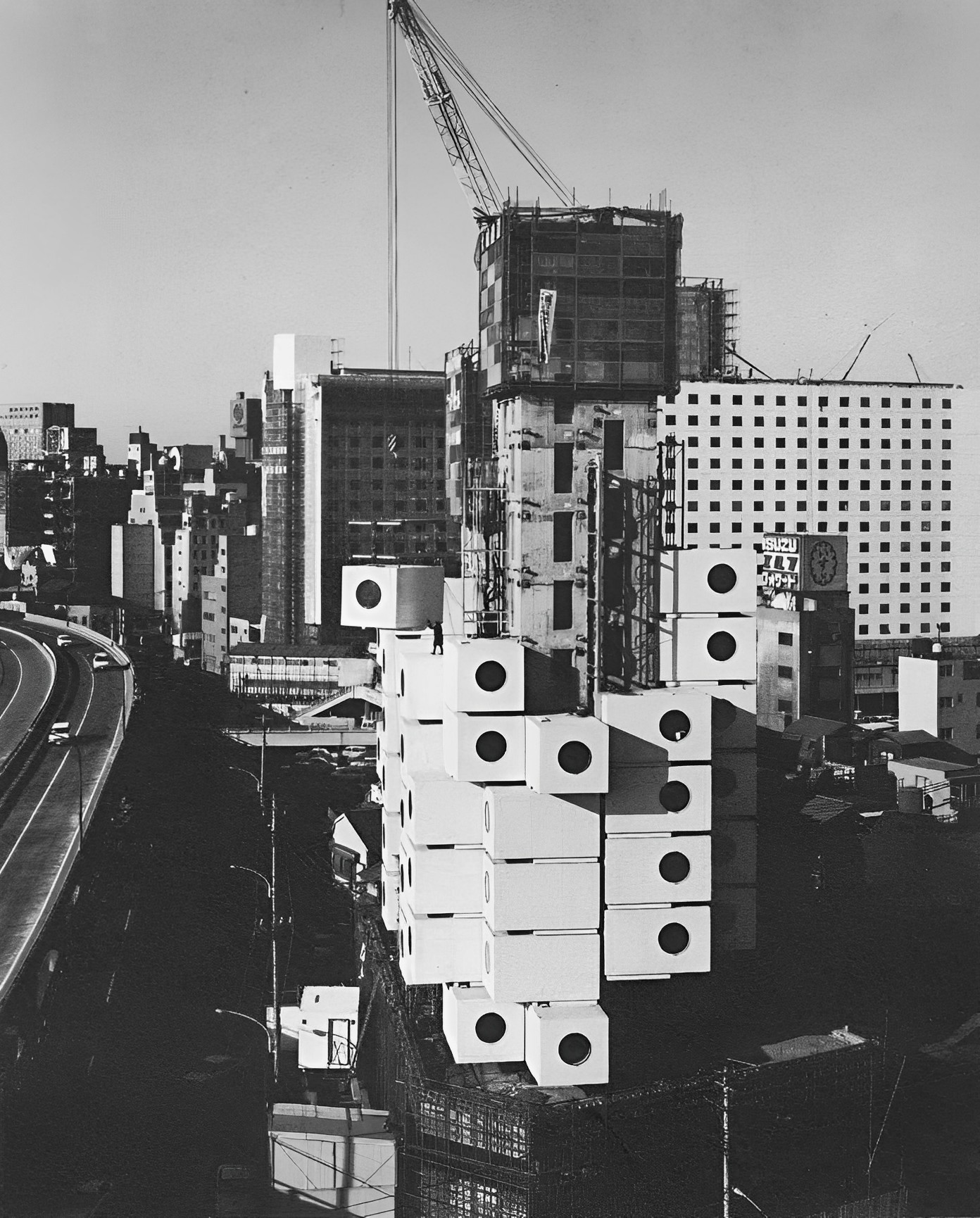
The Nakagin Tower has 140 capsules, each sold for between £5,000–£7,000 within one month of erection. A prototype was placed on the ground and inspected before people bought them. The quick sale represents a pay-off on a financial gamble since the market was not known-except roughly as that of ‘in-town bachelors’. Actually, 30 per cent of the units have been bought by companies whose head office is in another city. When a representative comes to Tokyo to negotiate he stays in the company capsule rather than a hotel as it is cheaper in the long run. Another 30 per cent are used by families as an extension to their house – as studies, playrooms, studios or dens. This unpredicted usage led Kurokawa to a new notion (and neologism) the ‘time-community’, that is a community of individuals not based on the traditional determinants of place or location, but the different activities any individual would perform over time. A businessman might inhabit five or six different places in any one day, each of them being a momentary community. This, it turns out, is again somewhat traditional since the Japanese do not usually entertain at home, but rather take guests to one of the evening clubs that exist everywhere: transposed living rooms as it were.
As Kurokawa points out, Homo movens, the man who spends much of his time travelling and moving house, is a phenomenon of modern America and Japan, but, as he adds characteristically, there is a traditional precedent. The sixteenth-century poet Basho said ‘travelling is a kind of home’. Kurokawa himself spends roughly 20 per cent of his time outside of Japan and another 20 per cent in local cities outside of Tokyo – which means he spends a lot of his life in hotels, cars, aeroplanes (a point he wishes to extend generally as ‘capsule architecture’).
Roughly 20 per cent of the capsules are used in the predicted way by bachelors. Since the tower is located near the Ginza, the entertainment district, it is convenient ‘as an executive hotel, after the businessman has finished his rounds on a late winter’s night, and doesn’t have the energy to return home’. The remaining 20 per cent are used in miscellaneous ways; the only buyer who has complained, a tailor, obviously hasn’t read the report of Kurokawa’s Checking and Evaluating Space Committee, because he uses his two capsules as fitting rooms and then objects that they don’t work well as entertainment areas.
Whether or not capsule living becomes an accepted alternative in the future remains to be seen; in spite of mass production they are no cheaper than conventional rooms and Kurokawa offers them not as an economic panacea but rather as forms for a new way of living.
As can be seen in Chapter 2, he invests capsule architecture and travel with a kind of profound significance, and one that might arouse scepticism in the West. He believes that Homo movens will lose the age-old desire to own possessions and stately homes, and instead will go after the new status symbols of free movement and extensive credit. What’s more the nuclear family will become less important as individualism and diversity increase. Capsule architecture will promote these trends. At such points, Kurokawa blends his own hopes with the projection of certain trends, possibly underrating the continued influence of traditional mores.
In this he is being the typical modern architect wishing to give form to a new social life that hasn’t yet quite arrived, even in Japan. In spite of his hopes, the hotel and department store are not yet the ‘new spiritual havens’ which are equivalent to the ancestral home and religious shrine. They lack, quite obviously, the ritual and significance of these former institutions.
What business are we in?
With Kurokawa’s success has arisen the attractive problem that confronts growing business firms, the shosha, the trading and manufacturing giants such as Mitsubishi. They have become involved in such heterogeneous activity that no single person understands the whole process, much less controls it. As a result these shosha have developed vast information networks extending over the globe which are reputed to be quicker and broader than other information services. They keep an up-to-date flow of news on changing markets, raw materials and new ideas – an obvious necessity for a country which has no national resource except its people. In architecture there are two hundred magazines devoted to the subject, two of which specialize in importing foreign ideas. ‘We import ideas and export things,’ a young Japanese architect told me. ‘Ideas don’t cost or weigh anything, and so we can make a good balance of trade by turning these ideas into objects and selling them back to you.’ An inexact statement, but one can see what he meant. On the one hand radio and tv sets assembled in Japan; on the other hand utopian ideas borrowed from architects around the world. Here some of them are built.
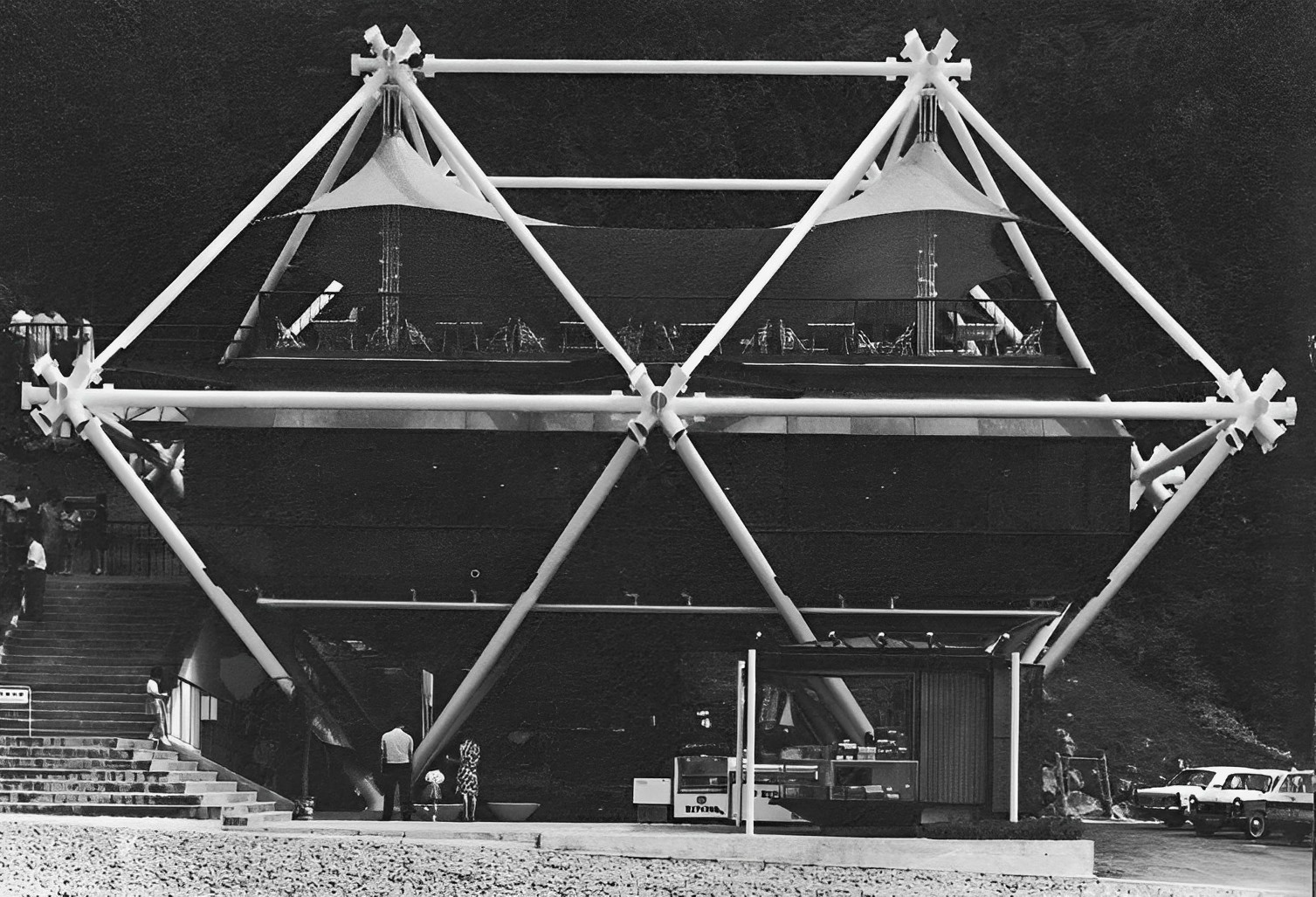
Kurokawa has imported the architectural notions of Jane Jacobs and Team Ten as well as the techniques of Herman Kahn and the Rand Corporation.
‘In Japan there are forty to fifty people actively engaged in thinking about the future. I am the chairman of the Think Tank Association, which includes one hundred small, informal groups and five large ones. Every week my group, the Institute for Social Engineering, has a meeting. Various governmental ministries give us money and we make specialized studies such as how the economy will grow across different social groups, or whether to manufacture many VTOLS [vertical take off and landing planes necessary for Japan’s mountainous regions]. We also make general predictions for the year 2000 – and we foresaw that Japan’s GNP would pass Germany to become number two in the world.’
In the West ‘social engineering’ has unattractive overtones and Think Tanks have had a dubious political involvement. His approach would be termed technocratic and associated with the right wing. When asked about the political implications of his Institute Kurokawa commented:
‘No, that’s not same here. Both Tanaka of the right wing and Minobe of the left, that is both the prime minister and the governor of Tokyo, say, “Kurokawa agrees with me.” Tokyo is occupied 60 per cent by the left wing and the National Chamber is 60 per cent right wing; the city is left, the whole is right. That’s a good combination. Attacking is a good training for people, to hear both opinions.
I am not left side.
I am not right side.
I am an architect.
I attack both sides.’
This nice little jump into doggerel seemed evasive at first, another example of the Buddhist dream of having it both ways at once. But on further reflection and questioning I saw how inadequate was the dichotomy – capitalist/socialist – applied to him. His way of life and tastes were capitalist, but many aspects of his firm were socialist and furthermore he did seem to attack both sides with a certain consistency.
‘Tanaka wrote a book about the Revolution of Japan, how to change it by building many expressways, and decentralizing by 1985. A popular magazine asked me to reply and I wrote an article against his policy.* I said rapid growth is very harmful for Japan and we should not rebuild every home by 1985, that would make impossible living conditions. Decentralization of urban areas is also bad because that would destroy local culture. Pollution and traffic jams may be bad but they’re better than killing local culture. Tanaka promoted decentralized industry, but my research institute showed that industrialization is not the key. By 1964 we had become a post-industrial society in terms of statistics and work force. Maybe, I said, we should increase tertiary industry, administration, university research, etc., and centralize commercial expertise. We will have 15 million new people by 1985 and this amount I don’t want to live in the big cities – so there will be a two-way flow.
____________
* The policy failed partly because Tanaka wrote the book revealing his plans thereby pushing up the land values.
‘After several criticisms, Tanaka asked me to debate with him on TV. He said on TV that a city must be a certain size and have 250,000 people. I answered that cities must have many different scales, an opinion backed up by many different experts. Decentralization failed once again.’
A certain pride conveyed through this matter-of-fact description was not surprising. It would be hard for Kurokawa to describe himself without boasting. How can you list membership in twenty-seven different societies and government committees in a humble way? Underneath all this effort must have been a new version of a traditional fanaticism, so it was not surprising when Kurokawa said that the person he respected most in modern Japan was Mishima. Japan admires a man who goes to extremes for an idea and is always ready to make a hero, as it has with Onoda, who spent the last twenty-five years continuing to fight the Second World War until he was personally pardoned from this duty by the Emperor.
But ‘fanaticism’ is again a Western construct on the matter and it does not seem to apply to a person who is so gentle, unassertive and, on the surface, well balanced. In fact, humble at times. But again perhaps there is a Buddhist tradition behind this; the way one is supposed to transcend ego in total involvement to become at once selfless and the top Buddha. When Kurokawa is criticized it is because he is too perfect; one imagines that, like James Bond, if he were in a street fight not a hair would be knocked out of place that wasn’t carefully premeditated in its disarray. Naturally many people, especially architects, are jealous and he has been slandered in various ways.
One newspaper report said a city hall he had designed was beginning to sag, because the cantilevers hadn’t been calculated right; another said he fathered a child with a famous actress; another that he was a rich man who received one million dollars for a rough sketch design.
This kind of personal vilification brought a serene smile to Kurokawa’s lips, as he relished the jealous hatred he could inspire. He was above the crude, negative tactics of his enemies; he was triumphant and had no need of underhand activities. After all he had to turn down most of his architectural offers, he had to refuse 900 invitations to lecture per year, while Tange, the previous giant of Japanese architecture, was in Saudi Arabia looking for work. I was reminded of the bitter struggle during the Renaissance, Benvenuto Cellini’s boasts and intense competition; he always had to prove he was the best artist. ‘Every day I must prove I can do it.’ Kurokawa said of his architecture. ‘Some Japanese architects don’t think I can produce good architecture because of my Think Tank and planning, so I must show them and work eighteen hours a day. ’
With this remark a large chunk of the puzzle falls into place. It reveals one reason for his extreme motivation and the way this keeps his various activities from flying apart into the formless growth of a shosha. Why also the seminars are so necessary: they integrate ‘Kisho Kurokawa, Architect and Associates’ into one body with many limbs, many information antennae and one head. That evening, as Kurokawa was taking me from one club to another in the Ginza district, we came across a demonstration against President Ford’s impending visit. A line of white-helmeted youths was running down the street, each individual holding on to the one in front, burying his head while running, the whole agitated centipede being chased by police in black helmets and armoured vehicles. I asked naïvely why the youths held on to the line and then saw what happened if they didn’t. As soon as one became unattached from the white group, he would be ritually pummelled and absorbed into the black group, the whole silent dance between the two groups taking place without any personal expression. Apparently the individual in Japan can express almost any shade of opinion he wishes as long as he does it by joining the means of expression, the group.
Finally, the most surprising thing about Kurokawa is that he is kind, a good listener and humble. A cynic might point out that with all his success he can well afford to be humble, or that these qualities have aided his career – which they no doubt have. Still, their existence is unexpected. If he were Western, his drive and ambition might have made him aloof and aggressive, or perhaps distorted and specialized in some way. But there are no obvious exaggerations to his character, no compensations which we have come to associate with such men. In fact Kurokawa’s main contribution for us may be in combining aspects usually taken as mutually exclusive in the West: the futurist and traditionalist, the paternalist and libertarian, the successful businessman and artist, a man who innovates on many different levels, yet unlike a member of the Western avant-garde is a popular and accessible person. These are just a few of the Western oppositions he has merged, if not overcome. Perhaps it is simply a case of Eastern culture taking its course when confronted with Western ideas and technology, the ritual emphasis on complementary qualities, yin and yang, feminine and masculine. In any case Kurokawa forces us to re-examine stereotypes that go back at least one hundred years, not only concerning Japan, but about what an individual can be.
C. J., London 1976
Sample pages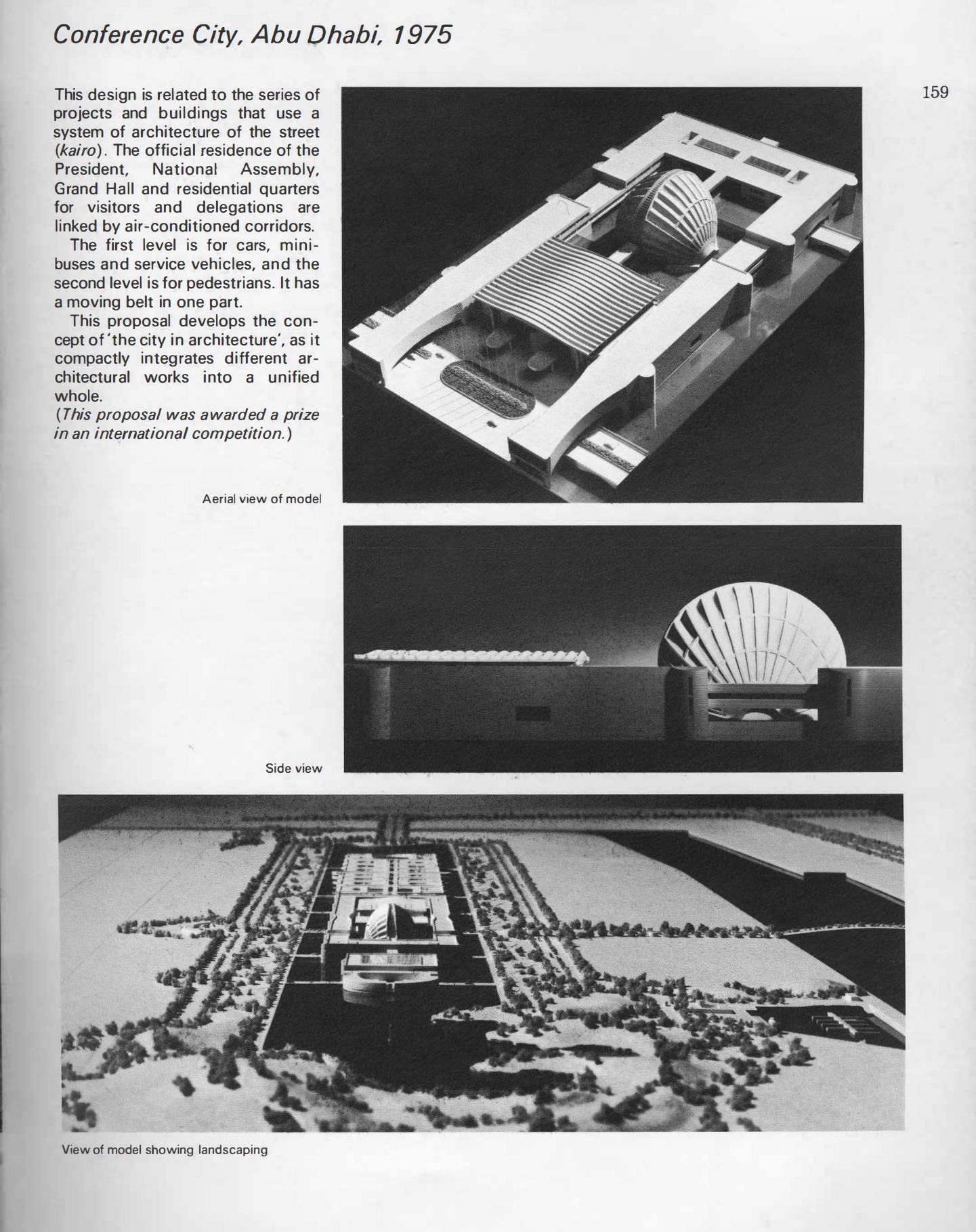 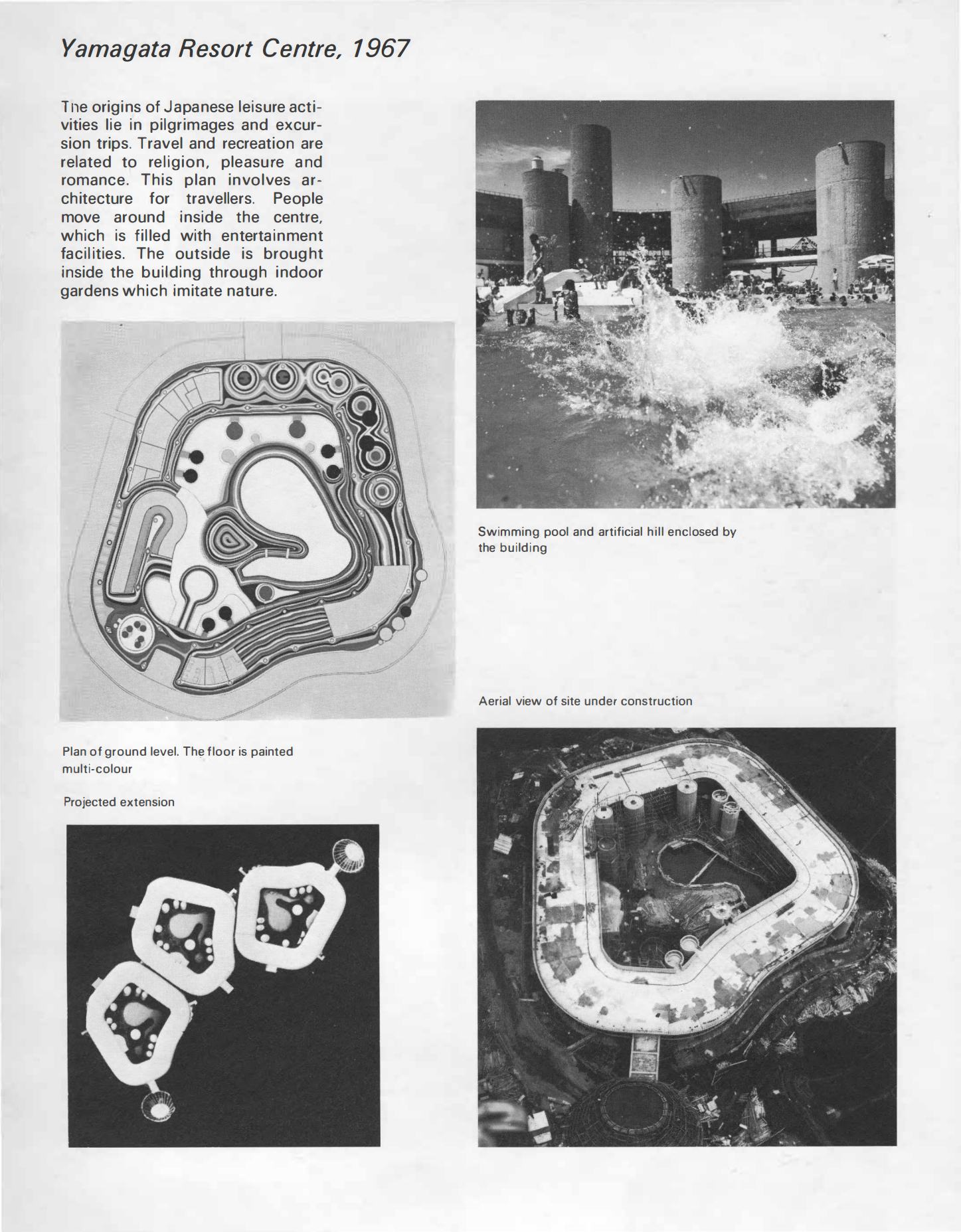
Download link (pdf, yandexdisk; 62.3 MB)
The electronic version of this edition is published only for scientific, educational or cultural purposes under the terms of fair use. Any commercial use is prohibited. If you have any claims about copyright, please send a letter to 42@tehne.com.
5 июля 2023, 17:07
0 комментариев
|
Партнёры
|






Комментарии
Добавить комментарий